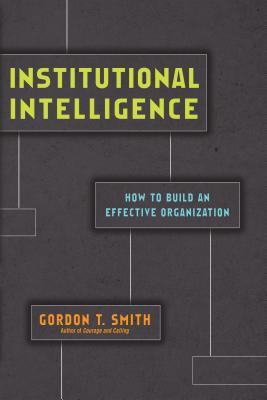The Book


Institutional Intelligence
Drawing on rich theoretical insight and years of lived investment in institutions, Smith has written a veritable handbook for the future of faithful work. I can’t imagine anyone who shouldn’t read this.

Professor, author, editor, Comment magazine
Mission
The capacity to think and function in light of institutional mission.
Everything rests on this: clarity about why this organization exists – its identity and its purpose. Every decision about the organization, including decisions about who is hired and how the budget is determined, comes back to mission: who are we? What is our mission?
This is not merely about a mission statement; though that is a good point of reference. It means, at the very least, the following;
What industry are we in? Are we a school, a church, an art gallery, an advocacy agency, a development or perhaps a civic organization.
Within that industry, what distinguishes us? What makes us unique – not special, just unique: what is our particular sphere of opportunity and responsibility?
And then, given our institutional purpose, can we frame and live out this mission in a way that is financially sustainable and compelling?
Mission then becomes the compass – sustained by the rhetoric of the senior leadership team and implemented by the key team members within the organization [the staff, or in the case of a college or university, the faculty].
The board are then the trustees of the mission.
Assessment is about intentionally asking: what is our mission and what is the evidence that the mission is actually happening?
Essential Reading:
Gordon T. Smith. Institutional Intelligence (IVPress, 2017), Chapters 2 and 3.
Peter Drucker. Managing the Non-profit Organization: Principles and Practices. Harper Business, 1990
Governance
The capacity to know how governance works within a particular institution.
Institutions only flourish if they are well governed. It is as simple as that. And, as often as not, the lack of institutional effectiveness as often as not comes back to governance since this is where the decisions are made and the leadership happens that assures that the other elements of institutional effectiveness are addressed.
Governance is about making and implementing good decisions in a way that is effective and accountable. Thus, it comes down to three institutional capacities:
First, the capacity of the organization to come to wisdom about what needs to be done. It is about getting the wisdom – internally or from external sources – for the needs and priorities and future of this particular organization.
Second, it is about coming to decision – based on that wisdom. It is about coming to a decision that then leads to action: we need closure that is acted on. We come to a decision; and someone has the power to implement that decision. The use of the word power is intentional: governance is about the stewardship of power – the capacity to do what needs to be done.
And third, it is about accountability.
Governance can break down at any one of these points – a lack of a learning culture that fosters good conversation and the pursuit of wisdom, or a culture that undercuts the capacity of leadership to act, or the lack of effective mechanisms for accountability.
We need to be able to discuss and learn together. Then someone needs to have the capacity to act – to exercise power and do what needs to be done. And whoever so acts needs to be held accountable.
We should also note that an effective organization also understands what is meant by a “conflict of interest”; they get it and they avoid it.
Essential Reading:
Gordon T. Smith, Institutional Intelligence (IVPress, 2017), Chapters 4 and 5.
Michael Jinkins and Deborah Bradshaw Jinkins. The Character of Leadership: Political Realism and Public Virtue in Nonprofit Organizations. Jossey-Bass, 1998
Human Resource
The human resource capacity: knowing for themselves and others how people are appointed or hired, how they develop and flourish within the organization and how they transition well when they complete their time with the organization.
Organizations are ultimately about people on mission together: the right people on the bus, to reference the great image from Jim Collins in Good to Great. Effective organizations are effective because (1) they hire well, (2) they are places where those who are hired are developed and flourish, and (3) they transition well when a person’s tenure with the organization is complete.
They have policies in place – and honor those policies: policies that reflect their commitment to make this organization a great place to work.
Few decisions if any are as crucial to the effectiveness of an organization as the quality and character, the talent and commitment, of the people they hire. Great organizations attract talent; and they hire well. And they do it again and again. They are unabashed in their commitment to recruit well – to wait until they get someone who understands the mission and has the right expertise for the essential role for which they are being hired.
Those who are hired have clarity about their sphere of responsibility and they know two things: to whom are they accountable for the quality and character of their work; and, they know how to work laterally with others to accomplish the shared outcomes that are essential to the mission of this organization.
Essential Reading:
Gordon T. Smith, Institutional Intelligence, IVPress, 2017. Chapter 6.
Henry Cloud, Necessary Endings: The Employees, Businesses, and Relationships that All of Us Have to Give Up in Order to Move Forward. Harper Business, 2010
Organizational Culture
The capacity to read institutional culture and play a part in fostering a dynamic and generative organizational culture.
Effective organizations know that culture matters – and more, that culture can be managed or, perhaps better put, nurtured. We can be intentional about encouraging a culture that is congruent with organizational mission and identity so that we are able to speak about what it “feels” like to work at or be part of this organization. And the language of affect is used intentionally.
Crucially, institutional culture needs to be characterized by a hopeful realism – not mere optimism, not a pseudo culture of mere sentimentality, but a dynamic capacity for seeing and naming reality that is matched by the possibilities of change, growth and innovation. A hopeful realism.
It means leaning into the best of one’s institutional culture: those elements that foster and encourage this hopeful realism.
And it means “starving” those elements – sometimes pathological elements – of the culture that undercut the capacity of the organization to flourish: to get things done, and to learn and grow and embrace the future.
Essential Reading:
Gordon T. Smith, Institutional Intelligence. IVPress, 2017. Chapter 7.
Edgar H. Schen, Organizational Culture and Leadership (2nd ed.). Jossey-Bass, 1992
Finances
The appreciation of the key role that money and finance plays in an organization – the economic factor.
The question is simply this: do we manage our financial assets in a way that makes it possible for the mission to happen? It all comes down to mission and money and the interplay between the two. There is no mission – it does not happen – if we do not manage the economics, and manage those economics effectively.
Negligence on the financial front means that the mission suffers. But that does not mean that money or finances or the annual budget are front and center. They matter; without a workable budget, the mission does not happen. But the crucial piece to remember is this: in the end it is not about a balanced budget or a surplus budget – which may sound like good news; it is about the mission. Did we manage our finances in our way that mean that the mission happened?
Thus the key to a good budget is that the expenditures are aligned with institutional purpose; money leverages mission.
Beyond this, it is imperative that the following is in place:
- A chief financial officer who works closely with the CEO and manages the budget process effectively;
- There is clarity about the financial position of the institution;
- There is an intentionality about fund development with a consistent and dependable donor base, with effective leadership from the CEO and others on this front;
- There is an understanding about the economic engine of the organization along with diversity – that is, multiple streams of revenue.
Essential Reading:
Gordon T. Smith, Institutional Intelligence. IVPress, 2017. Chapter 8.
William G. Droms. Finance and Accounting for Nonfinancial Managers: All the Basics You need to Know. Reading, Massechusets: Addison-Wesley: 1990.
Buildings and Spaces
The capacity to see and appreciate that all organizations are “housed” – they thrive only as they are properly located in built space, whether that is in buildings or in the virtual space of the internet.
Organizations are located; and the question is this: is the location – the built space in which the organization is housed – consistent with institutional identity and practical and adequate so that the organization can fulfill its purpose?
Buildings matter: they shape culture and foster or impede functioning. And those with institutional intelligence know two things: first, they know how to read a facility – to understand siting, layout, orientation and function. How this building works. And second, they know how to work within that space to maximize its potential for their responsibilities within the organization.
A teacher may insist that the space is not perfect, but he knows how to work with what she has for the sake of these kindergarten students. A librarian may know full well that the library is not what she would have designed as a library space if they had but asked her (!), but she knows how to work with this space, with all its limitations, to foster the capacity of the library to achieve its mission – either as a public library in a neighborhood, or the library of a small school.
They are not naïve about space. They do not assume that any space will do. Christian worship needs appropriate liturgical space. A university seminar for 12 students needs a space that is congruent with the purpose . . .not too big and not too small. As often as not a “multi-purpose” space or building is not appropriate for any of the multiple purposes that ostensibly are going to happen in that space. Those who oversee spiritual retreats know that there whether they are located in the heart of the city or isolated from the city, either way, there needs to be the capacity for quiet, stillness and that space can help or impede the purpose of the retreat.
Buildings need to be maintained, of course; and more, they need constant attention – renovation, re-design so that the organization can respond to new circumstances and opportunities. In other words, buildings learn. Thus renovations and maintenance is a part of life in a building.
And then, of course, there is the space of the world-wide-web: also, in a way, “built space”. The internet is a space in its own right; and more, all built space is now lived in and worked in differently because as a rule, we are all “connected.” Effective organizations have a vital and engaging web presence.
Essential reading:
Gordon T. Smith, Institutional Intelligence. IVPress, 2017. Chapter 9.
Witold Rybczynski. How Architecture Works: A Humanist’s Toolkit. (New York: Farrar, Straus and Giroux, 2013).
Strategic Partnerships
The capacity to appreciate that all organizations thrive only as they foster strategic alliances and partnerships.
No organization can achieve its mission without strategic alliances and partnerships. An institution is not self-sufficient but dependent – dependent, typically on a wide range of agencies, peer institutions, credentialing organizations that are each, perhaps in very different ways, essential to the capacity of this organization to achieve its mission.
Consider doing a taxonomy: what are the organizations – external to us – that are essential to our institutional mission? With whom do we need to work, collaboratively, in intentional partnership so that we all succeed?
Institutional intelligence, then is about two things. First, the capacity to recognize the crucial role that other agencies have in your own institutional mission. You need them. And second, the capacity to work effectively in true partnership and collaboration with others – mutual respect, a commitment to the success of both your agency and the success of the other.
And it means no “parasites”: that is, you do not only receive; you also give. You are not looking for only and merely your advantage. You are not seeking to draw on the benefits from another agency without considering how this partnership calls for your contribution to the greater good.
Essential Reading:
Gordon T. Smith, Institutional Intelligence. IVPress, 2017. Chapter 10.
Jane Arsenault. Forging Nonprofit Alliances. (Jossey-Bass, 1998).
I have written on this before, and was recently reminded through two conversations of the need to keep this topic or concern present to those who are following this blog. It was very awkward recently to…
If we have the assumption that no one person has all the wisdom that we need, for this organization – in this time and in this place – this means that we are listening to one…
A few years ago I was speaking at a week-end conference at a church in Washington state affiliated with the Presbyterian Church U.S.A. I was there a few weeks before the formal retirement date of the…
Recently a denominational leader within my denomination handed me a book with a fascinating and somewhat disturbing title: Let Us Prey: The Plague of Narcissist Pastors and What We Can Do About It, by Glenn Ball…
I am going to make a bold declaration: everything depends on governance – on getting it right and honouring the systems or protocols of good governance. Everything. Yes, I know that in Institutional Intelligence I sought…
When it comes to organizations – non-profit institutions – one is loathe to overstate anything, and yet you can hardly overstate the following: that so much depends on the quality and character of the working relationship…
Every organization that hires well will, without doubt, have a clear position profile – the job description – that includes both expectations of the role or responsibility along with the basis or terms on which one…
Within the world of graduate education and accreditation, we often use the language of “shared governance.” Two things here: first, I would suggest that there is wisdom here for how all organizations, including churches, function –…
The board of trustees of a non-profit are designed to provide an accountability for the leadership with this end in view: they are trustees of the mission and are the accountability body to assure that the…
It is often and rightly assumed that a board or a committee needs to have diversity of membership: that for a board to be effective in its deliberations, then diverse constituencies need to be at the…
There are few elements or factors in a working relationship as important and crucial as this: the confidence we each need to have in each other that we will do what we say we will do. …
When those in a senior leadership role – that is, in a position that assumes some level of authority, responsibility and thus leadership – do not lead, someone will always fill the vacuum; someone will lead…
 Gordon T. Smith
Gordon T. Smith